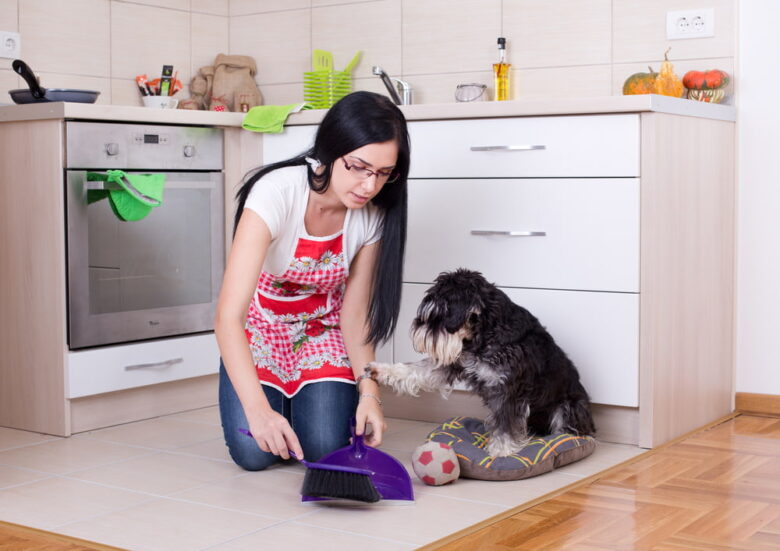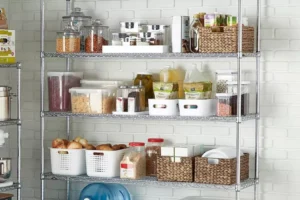If you live with pets, keeping your kitchen clean comes with some unique challenges. As much as we love our pets, their fur, spills, and sometimes even odors can make our homes messier. However, you can keep your kitchen clean and germ-free if you know what to do. This guide provides helpful tips on how to keep your kitchen clean so you and your pets are safe and comfortable.
Understanding the Importance of a Clean Kitchen
As the center of the home, the kitchen is the place where we cook, eat together and sometimes even invite others. Keeping the environment clean and sanitary is important to prevent foodborne illness and ensure everyone stays healthy. If you have pets, they can make it harder to keep things clean because they shed hair and spill things. Therefore, pet owners should clean in a way that is safe for their pets.
Create pet-free zones
It’s a good idea to create an area in your kitchen or dining room where pets are not allowed. This method helps keep pets away from areas where food is prepared, reducing the risk of accidents and contamination. Baby gates and other physical barriers can be used to gently but effectively reinforce these areas. This protects your pet and gives you peace of mind when cooking and preparing food.
Buy pet-friendly storage options
The best way to keep your kitchen clean is to organize your pet’s belongings. To keep pet food and treats fresh and prevent spills, you may want to purchase non-breathable containers. Special shelves or cabinets for pets will help keep your kitchen clean and tidy. This organization not only makes your room more usable but also prevents pets from eating food that could be harmful to them.
Why regular care is important
Grooming your pets regularly can reduce the amount of hair and dander they shed, making the kitchen less cluttered. Grooming your dog regularly can help you catch loose fur before it ends up on the floor or other surfaces. Pets with thick or long coats may need professional grooming to control shedding. This not only keeps your home cleaner, but it also helps your pets stay healthy and happy.
Choose floors that are easy to clean
The kitchen floor is often the most dirty place for pets. Cleaning will be much easier if you choose flooring materials that are easy to clean and maintain, such as tiles or laminate. Place washable rugs or rugs in high-traffic areas to make them safer. These not only catch spills but also give you a comfortable place to stand so you’re not too tired while cooking or cleaning.
Make sure the food and water bowls remain clean
To prevent the growth of bacteria and mold, clean your pet’s food and water bowls daily. Choosing a ceramic or stainless steel bowl will make cleaning easy and better for your health. Placing a mat under these bowls can also help catch any spills, making cleanup easier and keeping your floors clean.
Address leaks and incidents immediately
When a mistake or spill occurs, clean up immediately to prevent stains and odors from entering. Having cleaning tools on hand makes it easy to quickly clear up messes and limit damage. Enzyme cleaners work well on tough stains, such as those on carpets, because they break down stains and odors at the molecular level.
Use pet-safe cleaning products
Even when choosing cleaning supplies, your pet’s safety should always come first. Many store-bought cleaning products contain toxins that are harmful to pets. Instead, choose natural cleaning products that are safe for pets and get the job done without the risks. Garlic, baking soda, lemon juice, and vinegar are all safe ingredients that are great for many cleaning jobs.
Effective waste management
To keep your kitchen clean, properly disposing of pet waste is important. Reserve a garbage can specifically for pet waste, especially one with a lid that seals tightly to keep out odors and insects. Litter box mats are very useful for cat owners because they catch litter and keep the area around the litter box clean.
Let pets do good things
Teaching your pet the rules can help keep your kitchen clean. Counting the number of people who do things like stay out of the kitchen while cooking or eating can help prevent accidents and messes. When you use rewards during training, you make following the rules seem like a good thing, making it easier for you to stick with it.
Bedding and toys should be washed regularly.
Pet toys and beds can collect dirt, hair, and odors, making the kitchen less clean. Washing these regularly will not only keep them clean and fresh but also keep the house clean in general. To make things easier, choose pet toys and blankets that are machine washable.
Conclusion
Pets bring joy and companionship to our lives, but they also make it harder to keep the kitchen clean. That said, with the right techniques and a little work, it is possible to make your kitchen look clean and inviting. By following these tips, you can make your home a warm and clean place for you and your pets.
FAQs
1. How often should I brush my pet to prevent it from shedding in the kitchen?
How often you need to clean your pet depends on the breed, coat type, and personal needs. In general, grooming your pet several times a week can significantly reduce shedding. If your pet has long or thick fur, you may need to clean it more often. You can get personalized help by talking to a professional groomer or veterinarian.
2. Do you have any recommendations for pet-safe cleaning products?
Different brands may be better than others, but in general, look for items that claim to be safe for pets or made from natural ingredients. Pet-friendly families should generally choose brands that focus on formulas that are safe for dogs and the environment. Always read the label and ask your doctor if you are unsure.
3. What should I do if my pet finds food in the kitchen and eats it?
Yes, foods like chocolate, grapes, onions, and xylitol (the sweetener in some sugar-free foods) can be harmful to pets. It is important to keep these and other dangerous items locked up and out of the reach of pets.
4. What should I do if my pet poops in the kitchen?
Removing mistakes immediately is important to maintain cleanliness and prevent stains or odors. Use an enzymatic cleaner that is pet-safe and removes odors and stains. If the problem persists for a long time or affects a large area, you may need to hire a professional cleaner.
5. How do I teach my pet not to go into the kitchen?
Teaching your pet to stay out of the kitchen requires perseverance, caring, and positive reinforcement. To get your pet to behave the way you want, use instructions, treats, and praise. It is also helpful to have barriers such as baby gates when training your dog. For personal advice and planning, it can be useful to work with a professional teacher.
6. What are the signs that my pet’s toys or bed need cleaning?
Some signs include a strong odor, visible dirt or stains, and lots of fur. Checking and cleaning your pet’s belongings regularly will keep them fresh and improve your kitchen and home.



